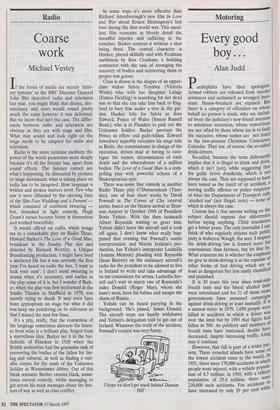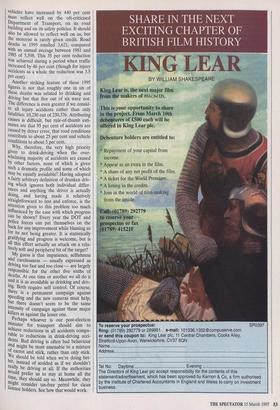Motoring
Every good boy ...
Alan Judd
aedophiles have their apologists. Armed robbers are released from murder sentences and acclaimed as wronged inno- cents. House-breakers are excused. But there is a category of offenders on whose behalf no protest is made, who are exclud- ed from the judiciary's new-found aversion to minimum sentences, whose convictions are not sifted by those whose joy is to fault the executive, whose names are not listed in the bien-pensant Christmas Conscience Calendar. They are, of course, the so-called drink-drivers.
So-called, because the term dishonestly implies that it is illegal to drink and drive, which it isn't (yet), while suggesting that the guilty drove drunkenly, which is not always the case. They are supposed to have been tested as the result of an accident, a moving traffic offence or police suspicion of what the Department of Transport calls `alcohol use' (not illegal, note) — none of which is always the case. Custom has it that anyone writing on the subject should express due abhorrence before saying anything. Child murderers get a better press. The only journalist I can think of who regularly abjures such public piety is Auberon Waugh, the seer. I suspect the drink-driving law is framed more for convenience than fairness, but let that be. What concerns me is whether the emphasis we give to drink-driving is at the expense of other forms of bad driving which are at least as dangerous but less easily identified and punished. It is 30 years this year since road-side breath tests and the blood alcohol limit were introduced and for 21 of those years governments have mounted eampalgOs against drink-driving at least annually. It is a success story: in 1979, 1,650 people were killed in accidents in which a driver was over the limit but by 1995 that figure had fallen to 580. As publicity and numbers of breath tests have increased, deaths have decreased, despite increasing traffic. Long may it continue. However, that fall is part of a wider pat- tern. These crowded islands have some of the lowest accident rates in the world..In 1951, there were 178,000 accidents in which people were injured, with a vehicle popula- tion of 4.7 million; in 1995, with a vehicle population of 25.4 million, there Were 230,000 such accidents. For accidents to have increased by only 29 per cent while vehicles have increased by 440 per cent must reflect well on the oft-criticised Department of Transport, on its road building and on its safety policies. It should also be allowed to reflect well on us, but the motorist is rarely given credit. Road deaths in 1995 totalled 3,621, compared with an annual average between 1981 and 1985 of 5,598. This 35 per cent reduction was achieved during a period when traffic increased by 46 per cent (though for injury accidents as a whole the reduction was 3.5 per cent).
Another striking feature of these 1995 figures is not that roughly one in six of these deaths was related to drinking and driving but that five out of six were not. The difference is even greater if we consid- er all injury accidents rather than only fatalities: 10,230 out of 230,376. Attributing causes is difficult, but rule-of-thumb esti- mates are that 95 per cent of accidents are caused by driver error, that road conditions contribute to about 25 per cent and vehicle conditions to about 5 per cent. Why, therefore, the very high priority given to drink-driving when the over- whelming majority of accidents are caused by other factors, none of which is given such a dramatic profile and some of which may be equally avoidable? Having adopted a fairly arbitrary definition of drunken driv- ing which ignores both individual differ- ences and anything the driver is actually doing,and having made it relatively straightforward to test and enforce, is the attention given to this problem too much Influenced by the ease with which progress can be shown? Every year the DOT and Police forces can pat themselves on the back for any improvement while blaming us for its not being greater. It is statistically gratifying and progress is welcome, but is all this effort actually an attack on a rela- tively soft and peripheral bit of the target? My guess is that impatience, selfishness and carelessness — usually expressed as driving too fast and too close — are largely responsible for the other five sixths of deaths. At one time or another we all do it and it is as avoidable as drinking and driv- ing. Both require self control. Of course, there is a permanent campaign against speeding and the new cameras must help, but there doesn't seem to be the same intensity of campaign against these major killers as against the lesser one. Perhaps whoever is our post-election minister for transport should aim to achieve reductions in all accidents compa- rable to reductions in drink-driving acci- dents. Bad driving is often bad behaviour and might be most amenable to a mixture of carrot and stick, rather than only stick. We should be told when we're doing bet- ter, instead of scolded as if we shouldn't really be driving at all. If the authorities Would prefer us to stay at home all the time, they should say so. Meanwhile, they 'night consider tax-free petrol for clean licence holders. See how that would work.



































































 Previous page
Previous page